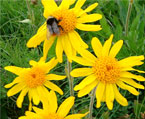



Arnica is a perennial that grows from 1 to 2 feet. 1,2 Its oval, opposite leaves form a basal rosette close to the soil surface. It has bright yellow, daisy like flow?ers.1-3 The dried flower heads are the primary parts used from the plant. The rhizome is also used.2,4 Arnica is native to the mountainous regions of Europe to southern Russia.3,4 The unrelated plant, monkshood (Aconitum spp) is sometimes referred to as wolf's bane.
Internal and external preparations made from the flowering heads of arnica have been used medicinally for hundreds of years. Alcoholic tinctures were used by early settlers to treat sore throats, as a febrifuge, and to improve circulation. Homeopathic uses included the treat?ment of surgical or accidental trauma, as an analgesic, and in the treatment of postoperative thrombophlebitis and pulmonary embolj,5 It has been used externally for acne, bruises, sprains and muscle aches, and as a general topical counterirritant.6 Arnica has been used extensively in European folk medicine. German philosopher Johann Wolfgang von Goethe (1749-1832) was said to have drunk arnica tea to "ease" his angina.2 Arnica's bactericidal properties were employed for abrasions and gunshot wounds?
A number of flavonoid glycosides have been identified in arnica. Flavonoids (0.4% to 0.6%)3 include betuletol, eupafolin, flavonol glucuronides his?pidulin, isorhamnetin, luteolin, patuletin, spinacetin, tricin, , -trihydroxy--trimethoxyflavone, kaempferol, quercetin,9 and kaempferol and quercetin derivative,lO jaceosidin, and pectolin-arigenin.4 Isomeric alcohols include arnidiol and foradiol.
Terpenoids in arnica include arnifolin, arnicolide,2 sesquit?erpenes (helenalin9 and helenalin derivatives, dihydro?helenalin, etc). Pseudoguaianolide helenalinmethacry?late, a helenalin ester, has been isolated from the flowers.
Amines present in the plant are betaine, choline, and trimethylamine. Coumarins include scopoletin and umbel liferone.
Carbohydrates such as mucilage and polysaccharides (ie, inulin) are found in arnica. Two homogeneous polysaccharides, for example, include an acidic arabino?3,6-galactan-protein, and a neutral fucogalactoxyloglu?can.13 Further polysaccharide isolation has been per?formed on a group of water-soluble acidic heteroglycaines.
Volatile oils (0.3% to 1 %) may be obtained from rhizomes and roots or from flower parts (used in perfumery)? Constituents in the oil include thymol, its derivatives,2 and fatty acids (palmitic, linoleic, myristic, and linolenic).4 The fatty acid content in arnica leaf essential oil has been evaluated, as wel1.
Other components found in arnica include bitter com?pound arnicin, caffeic acid,7,9 carotenoids (alpha- and beta-carotene, cryptoxanthin, lutein),4,9,16 phytosterols, resin, tannins,2,4 and anthoxanthine?
Not only is arnica employed in hair tonics, antidandruff preparations, perfumery, and cosmet?ics, it is used in herbal and homeopathic medicines as, wel1.4,7 The plant possesses a slight anti-inflammatory and mild analgesic effect, most likely due to the sesquit?erpene lactones. Helenalin and dihydrohelenalin exert mild anti-inflammatory and antibacterial activity.6,9 They expressed anti-inflammatory activity in mice and rats,4 and in humans, as well. Arnica improved feelings of stiffness associated with hard physical exertion (vs pla?cebo) when tested in 36 marathon participants in a double-blinded, randomized trial. However, in another report, contradictory results were seen.
Patients who had impacted wisdom teeth removed re?ceived either metronidazole, arnica, or placebo. Metro?nidazole was more effective than arnica in controlling postoperative pain, inflammation, and healing. Patients receiving arnica had greater pain and inflammation than those receiving placebo.
Arnica contains a group of polysaccharides with 65% to 100% galacturonic acid that can inhibit the complement system, thereby modifying the immune system re?ponse.19 This polysaccharide displays marked phago?cytosis enhancement in vivo. Yet another compound
Copyright © Krishna Herbal Company 2022. All Rights Reserved Powered By: Planet Ayurveda







